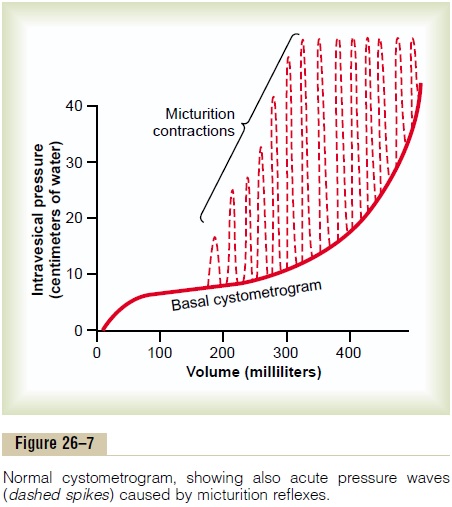Chapter: Medical Physiology: Urine Formation by the Kidneys: I. Glomerular Filtration, Renal Blood Flow, and Their Control
Micturition Reflex

Micturition Reflex
Referring again to Figure 26–7, one can see that as the bladder fills, many superimposed micturition contrac-tions begin to appear, as shown by the dashed spikes. They are the result of a stretch reflex initiated by sensory stretch receptors in the bladder wall, especiallyby the receptors in the posterior urethra when this area begins to fill with urine at the higher bladder pres-sures. Sensory signals from the bladder stretch recep-tors are conducted to the sacral segments of the cord through the pelvic nerves and then reflexively back again to the bladder through the parasympatheticnerve fibers by way of these same nerves.

When the bladder is only partially filled, these mic-turition contractions usually relax spontaneously after a fraction of a minute, the detrusor muscles stop con-tracting, and pressure falls back to the baseline. As the bladder continues to fill, the micturition reflexes become more frequent and cause greater contractions of the detrusor muscle.
Once a micturition reflex begins, it is “self-regener-ative.” That is, initial contraction of the bladder acti-vates the stretch receptors to cause a greater increase in sensory impulses to the bladder and posterior urethra, which causes a further increase in reflex con-traction of the bladder; thus, the cycle is repeated again and again until the bladder has reached a strong degree of contraction. Then, after a few seconds to more than a minute, the self-regenerative reflex begins to fatigue and the regenerative cycle of the micturition reflex ceases, permitting the bladder to relax.
Thus, the micturition reflex is a single complete cycle of (1) progressive and rapid increase of pressure, (2) a period of sustained pressure, and (3) return of the pressure to the basal tone of the bladder. Once a mic-turition reflex has occurred but has not succeeded in emptying the bladder, the nervous elements of this reflex usually remain in an inhibited state for a few minutes to 1 hour or more before another micturition reflex occurs. As the bladder becomes more and more filled, micturition reflexes occur more and more often and more and more powerfully.
Once the micturition reflex becomes powerful enough, it causes another reflex, which passes through the pudendal nerves to the external sphincter to inhibit it. If this inhibition is more potent in the brain than the voluntary constrictor signals to the external sphincter, urination will occur. If not, urination will not occur until the bladder fills still further and the micturition reflex becomes more powerful.
Facilitation or Inhibition of Micturition by the Brain
The micturition reflex is a completely autonomic spinal cord reflex, but it can be inhibited or facilitated by centers in the brain. These centers include (1) strong facilitative and inhibitory centers in the brainstem, located mainly in the pons, and (2) several centers located in the cerebral cortex that are mainly inhibitorybut can become excitatory.
The micturition reflex is the basic cause of micturi-tion, but the higher centers normally exert final control of micturition as follows:
1. The higher centers keep the micturition reflex partially inhibited, except when micturition is desired.
2. The higher centers can prevent micturition, even if the micturition reflex occurs, by continual tonic contraction of the external bladder sphincter until a convenient time presents itself.
3. When it is time to urinate, the cortical centers can facilitate the sacral micturition centers to help initiate a micturition reflex and at the same time inhibit the external urinary sphincter so that urination can occur.
Voluntary urination is usually initiated in the fol-lowing way: First, a person voluntarily contracts his or her abdominal muscles, which increases the pressure in the bladder and allows extra urine to enter the bladder neck and posterior urethra under pressure, thus stretching their walls. This stimulates the stretch receptors, which excites the micturition reflex and simultaneously inhibits the external urethral sphincter.
Ordinarily, all the urine will be emptied, with rarely more than 5 to 10 milliliters left in the bladder.
Related Topics